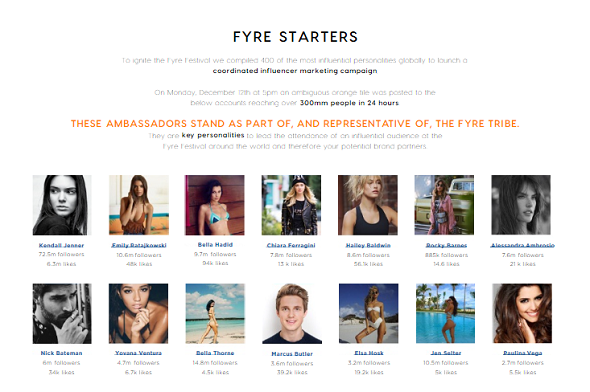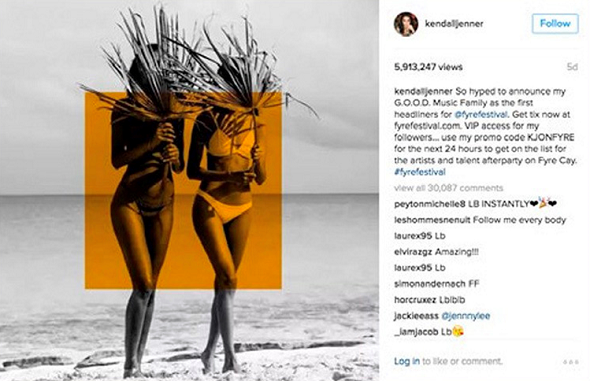


Lessons in Influencer Marketing from Fyre Festival
Influencer marketing fanned the flames of Fyre Festival, but it all went up in smoke. Are there any lessons to be salvaged from the ashes?

Nothing in recent memory has stirred such profound feelings of schadenfreude as the recent Fyre Festival fiasco. It had been advertised as a luxury festival experience unlike any other, set in idyllic Bahamian islands “formerly owned by Pablo Escobar” (because Columbian drug lords = aspirational) over “two transformative weekends”. Attendees paid between $1,500 for a day ticket to $12,000 for VIP packages. They were promised huge music acts, jet skis, yachts, gourmet dining, and the chance to take selfies with a bunch of famous people. It was gonna be “lit”. And then it went up in flames.

The festival was rooted in influencer marketing: it was promoted on Instagram by influencers - sorry, "Fyre starters" - such as Kendall Jenner, Bella Hadid and Emily Ratajkowski, and was organised in the first place to promote the Fyre talent booking app.
While Fyre was hugely successful in its marketing, it failed to deliver on its promise, raising some important questions about influencer marketing campaigns.
With that in mind, we pulled together some key points brands should consider before embarking on an influencer campaign of their own.
Know Your Audience
The one area where Fyre Festival succeeded was in building up hype. Its target persona was the sort of ultra-wealthy, image-obsessed person who thinks that Coachella could only be improved if it were more prohibitively expensive. Appropriately, the marketing strategy was as basic as the audience it targeted: throw thousands of dollars at celebrities and models to promote the festival on Instagram. Kendall Jenner was reportedly paid $250K for her involvement. And hey, it worked – various and sundry media platforms were parroting on about Fyre Festival being “Coachella x 1000” and the next big “FOMO” event, and thousands of tickets were sold. They chose the right influencers for the event they were trying to sell; that it all turned out to be bogus is another matter.

Thankfully, when it comes to influencer marketing, spending big money on big names isn’t the only tactic that works – and in many cases, it’s not even likely to be effective. The word “influencer” is often used interchangeably with “media personality”, but rather than being a generic statement about how famous someone is, the term is a subjective statement of their value to you. A personality is only an influencer from your perspective if they have the power to influence your target audience. The key thing is to find personalities who post content that is highly relevant to the product you want to promote, and who have a loyal follower base that are interested in this category.
Quality, not Quantity
It’s tempting to look at follower count as the best metric of how influential a person is. But how much are legions of followers worth if most of them barely engage? Impressions aren’t much good if they don’t lead to conversions, so quality of followers is just as important, if not more so, than quantity. If an Instagram account has tens of thousands of followers but only gets hundreds of likes per post, their audience are unlikely to be highly invested in them; on the other hand, an account with only a few thousand followers but who also gets hundreds of likes per post is going to have a highly engaged audience who trust and actively care about their opinion. Often, the smarter move is to go for the influencer with a smaller reach but a more dedicated audience.
Be Authentic
Influencers are mediators between a brand and their audience. Any brand worth their salt aims for a reciprocal relationship with their audience based on trust, mutual benefit and shared values. Your influencers should be an integral part of this equation, so you want a strong relationship with them. Compensation in the form of payment or free products is obviously going to be a central part of this relationship, but underlying the financial incentive, you need to show your influencers the value of being associated with your brand, and the affinity between your brand and theirs.
The best influencers inspire a feeling of personal connection in their followers, who are finely attuned to what seems natural for this personality – and what seems fake. If you choose influencers who are natural advocates of your brand, their promotional messaging will seem genuine to their followers, because it will be.
Be Responsible
First rule of marketing: have a good product. Fyre Festival is a case in point, demonstrating that while you can certainly generate a lot of hype about garbage, eventually the bubble will burst and you might end up embroiled in a lawsuit or several.
The false advertising that promoted Fyre Festival wouldn’t have been possible in a more traditional advertising campaign. Even online ads are held to strict standards about the truthfulness of their messaging. This incident highlights the slippery category of influencer marketing, which often falls somewhere between genuine personal endorsement and paid advertising. As such, promotional material is not always clearly identified as such.

Of course, advertising is more effective when it doesn’t look like advertising, but this disingenuousness probably won’t fly for much longer: the Federal Trade Commission are cracking down to enforce greater transparency.
Posted 12 May 2017